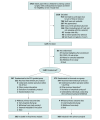Electroencephalography-Guided Anesthesia and Delirium in Older Adults After Cardiac Surgery: The ENGAGES-Canada Randomized Clinical Trial
- PMID: 38857019
- PMCID: PMC11165413
- DOI: 10.1001/jama.2024.8144
Electroencephalography-Guided Anesthesia and Delirium in Older Adults After Cardiac Surgery: The ENGAGES-Canada Randomized Clinical Trial
Abstract
Importance: Intraoperative electroencephalogram (EEG) waveform suppression, suggesting excessive general anesthesia, has been associated with postoperative delirium.
Objective: To assess whether EEG-guided anesthesia decreases the incidence of delirium after cardiac surgery.
Design, setting, and participants: Randomized, parallel-group clinical trial of 1140 adults 60 years or older undergoing cardiac surgery at 4 Canadian hospitals. Recruitment was from December 2016 to February 2022, with follow-up until February 2023.
Interventions: Patients were randomized in a 1:1 ratio (stratified by hospital) to receive EEG-guided anesthesia (n = 567) or usual care (n = 573). Patients and those assessing outcomes were blinded to group assignment.
Main outcomes and measures: The primary outcome was delirium during postoperative days 1 through 5. Intraoperative measures included anesthetic concentration and EEG suppression time. Secondary outcomes included intensive care and hospital length of stay. Serious adverse events included intraoperative awareness, medical complications, and 30-day mortality.
Results: Of 1140 randomized patients (median [IQR] age, 70 [65-75] years; 282 [24.7%] women), 1131 (99.2%) were assessed for the primary outcome. Delirium during postoperative days 1 to 5 occurred in 102 of 562 patients (18.15%) in the EEG-guided group and 103 of 569 patients (18.10%) in the usual care group (difference, 0.05% [95% CI, -4.57% to 4.67%]). In the EEG-guided group compared with the usual care group, the median volatile anesthetic minimum alveolar concentration was 0.14 (95% CI, 0.15 to 0.13) lower (0.66 vs 0.80) and there was a 7.7-minute (95% CI, 10.6 to 4.7) decrease in the median total time spent with EEG suppression (4.0 vs 11.7 min). There were no significant differences between groups in median length of intensive care unit (difference, 0 days [95% CI, -0.31 to 0.31]) or hospital stay (difference, 0 days [95% CI, -0.94 to 0.94]). No patients reported intraoperative awareness. Medical complications occurred in 64 of 567 patients (11.3%) in the EEG-guided group and 73 of 573 (12.7%) in the usual care group. Thirty-day mortality occurred in 8 of 567 patients (1.4%) in the EEG-guided group and 13 of 573 (2.3%) in the usual care group.
Conclusions and relevance: Among older adults undergoing cardiac surgery, EEG-guided anesthetic administration to minimize EEG suppression, compared with usual care, did not decrease the incidence of postoperative delirium. This finding does not support EEG-guided anesthesia for this indication.
Trial registration: ClinicalTrials.gov Identifier: NCT02692300.
Conflict of interest statement
Figures


Comment in
-
Anesthesia Dose and Delirium-A Picture Coming Into Focus.JAMA. 2024 Jul 9;332(2):107-108. doi: 10.1001/jama.2023.26819. JAMA. 2024. PMID: 38857024 No abstract available.
References
-
- Punjasawadwong Y, Chau-In W, Laopaiboon M, Punjasawadwong S, Pin-On P. Processed electroencephalogram and evoked potential techniques for amelioration of postoperative delirium and cognitive dysfunction following non-cardiac and non-neurosurgical procedures in adults. Cochrane Database Syst Rev. 2018;5(5):CD011283. doi:10.1002/14651858.CD011283.pub2 - DOI - PMC - PubMed
Publication types
MeSH terms
Associated data
Grants and funding
LinkOut - more resources
Full Text Sources
Medical

